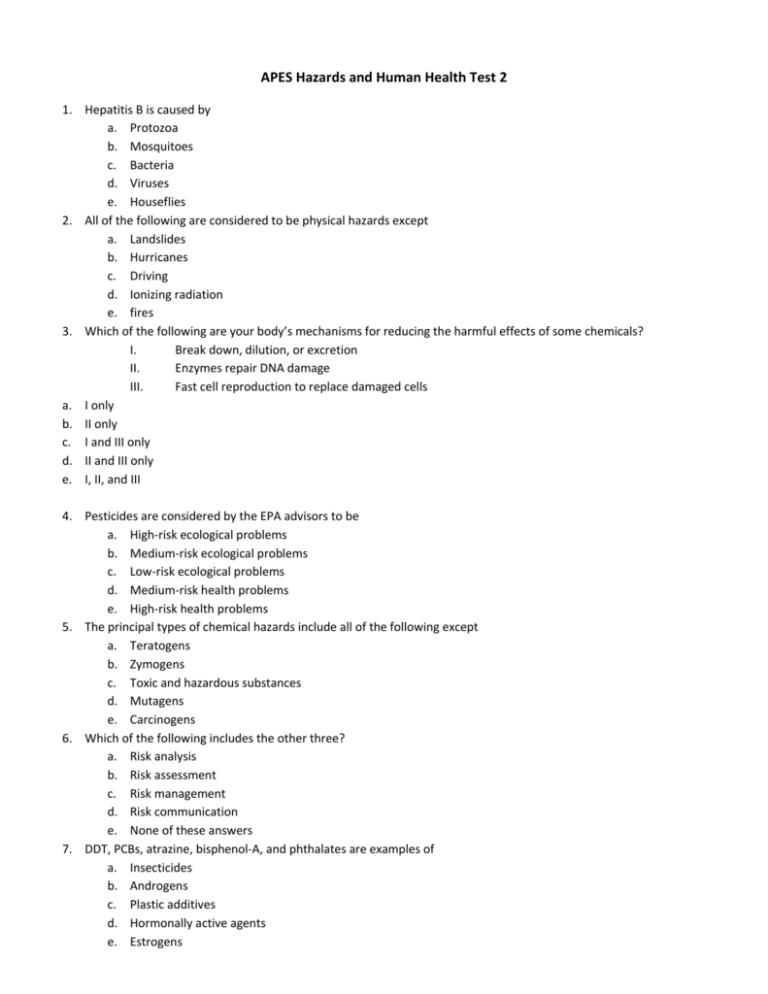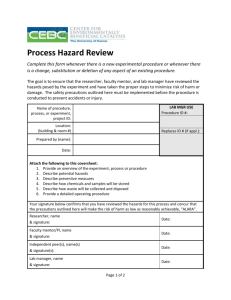APES Hazards and Human Health Test 2 Hepatitis B is caused by
advertisement

APES Hazards and Human Health Test 2 1. Hepatitis B is caused by a. Protozoa b. Mosquitoes c. Bacteria d. Viruses e. Houseflies 2. All of the following are considered to be physical hazards except a. Landslides b. Hurricanes c. Driving d. Ionizing radiation e. fires 3. Which of the following are your body’s mechanisms for reducing the harmful effects of some chemicals? I. Break down, dilution, or excretion II. Enzymes repair DNA damage III. Fast cell reproduction to replace damaged cells a. I only b. II only c. I and III only d. II and III only e. I, II, and III 4. Pesticides are considered by the EPA advisors to be a. High-risk ecological problems b. Medium-risk ecological problems c. Low-risk ecological problems d. Medium-risk health problems e. High-risk health problems 5. The principal types of chemical hazards include all of the following except a. Teratogens b. Zymogens c. Toxic and hazardous substances d. Mutagens e. Carcinogens 6. Which of the following includes the other three? a. Risk analysis b. Risk assessment c. Risk management d. Risk communication e. None of these answers 7. DDT, PCBs, atrazine, bisphenol-A, and phthalates are examples of a. Insecticides b. Androgens c. Plastic additives d. Hormonally active agents e. Estrogens 8. Of the 85,000 registered synthetic chemicals in commercial use, only ____ have been adequately tested to determine whether they are carcinogens, teratogens, or mutagens. a. 0.5% b. 1% c. 2% d. 3% e. 4% 9. All of the following are considered to be cultural hazards except a. Drugs b. Diet c. Smoking d. Drought e. Unsafe sex 10. The explosion of the space shuttle Challenger and the accidents at Three Mile Island and Chernobyl were caused a. By the northern lights interfering with normal electrical transmission b. Primarily by technological error c. By global climate change d. Primarily by human error e. None of these answers 11. Since 1900, and especially since 1950, the incidences of infectious diseases and the death rates from such diseases have a. Been greatly increased b. Been greatly reduced c. Remained at the same levels d. Increased then leveled off e. Decreased then increased slightly 12. Calculating the risk of a new technological system a. Requires assessment of human intelligence b. Requires assessment of technological reliability c. Require careful economic analysis d. Is impossible e. None of these answers 13. Match the statement with the best term listed. The term that is given to the type and amount of health damage that occurs from exposure to a chemical or other agent. a. Biomagnifications b. Persistence c. Dose d. Bioaccumulation e. Response 14. Match the statement with the best term listed. Refers to the amount of a substance a person ingests, inhales, or absorbs through the skin. a. Bioaccumulation b. Response c. Biomagnification d. Persistence e. Dose 15. Which statement is true? a. Natural chemicals are safe, and synthetic chemicals are deadly. b. Synthetic chemicals are deadly, and natural chemicals are safe. c. All chemicals are unsafe. d. Some chemicals, whether synthetic or natural, are safe and others are deadly. e. All chemicals are safe except those that cause cancer 16. The four main types of hazards include all of the following except a. Global hazards b. Biological hazards c. Physical hazards d. Chemical hazards e. None of the above 17. Match the statement with the best term listed. Relates the amount of a potentially toxic substance as it passes through food chains and webs. a. Persistence b. Response c. Bioaccumulation d. Biomagnifications e. Dose 18. In 1918, the highly potent virus that spread rapidly around the globe and killed between 20-50 million people within a few months was the a. Spanish flu b. Bird flu c. Hong Kong Flu d. Asian flu e. Common flu 19. In a developing country, you are most likely to fear health threats from a. Diabetes b. Unsanitary drinking water c. Ebola virus d. Hanta virus e. HIV 20. Match the statement with the best term listed. The term that is used to refer to chemicals that are resistant to breakdown and have long-lasting harmful effects on the health of wildlife and people. a. Persistence b. Response c. Dose d. Bioaccumulation e. Biomagnifications 21. The major cause of a reduced human life span today is a. High cholesterol b. Driving c. Poverty d. Smoking e. Cancer 22. According to a 2000 study, at least ____ of all antibiotics used to treat humans are prescribed unnecessarily. a. One-eighth b. One-quarter c. One-third d. One-half e. Two-thirds 23. Susceptibility to environmental stresses is increased in people already affected by a. Poverty b. Disease c. Malnutrition d. All of these answers e. None of these answers 24. Vectors are a. Parasitic organisms b. Estrogen mimics c. Dose levels d. Agents of infection e. Agents of disease transmission 25. A person receiving background radiation from a low-level radioactive dump site for a lifetime has experienced a. A subacute exposure b. A superacute exposure c. A chronic exposure d. A subchronic exposure e. An acute exposure 26. EPA science advisors consider all of the following to be high-risk ecological problems except a. Groundwater pollution b. Global climate change c. Stratospheric ozone depletion d. Species extinction and loss of biodiversity e. Wildlife habitat destruction 27. Vaccines can help prevent all of the following diseases except a. Polio b. Rabies c. Measles d. AIDS e. Mumps 28. You would predict that a hormone disrupter would most effect a(an) a. Producer b. Primary consumer c. Secondary consumer d. Tertiary consumer e. Secondary producer 29. All of the following are synthetic chemicals that can act as hormone mimics or hormone blockers except a. PCBs b. Adrenalin c. Dioxins d. DDT e. Some pesticides 30. Of the following chemicals, the least likely to cause birth defects is a. PCBs b. Thalidomide c. Heavy metals d. Iodized sodium chloride e. Steroid hormones 31. All of the following are expressions of harmful inheritable mutations in humans except a. Thalasseamia b. Hemophilia c. Sickle-cell anemia d. Cholera e. Manic depression 32. Mutagens a. Cause birth defects b. Are fatal to humans in low doses c. Are harmful because they are flammable, explosive, irritating to skin or lungs, or cause allergic reactions d. Cause mutations e. Always cause cancer 33. EPA science advisors consider indoor and outdoor air problems to be a. High-risk ecological problems b. Medium-risk ecological problems c. Low-risk ecological problems d. High-risk health problems e. Medium-risk health problems 34. The intake of synthetic mimics can severely disrupt the a. Respiratory system b. Digestive system c. Endocrine system d. Circulatory system e. Immune system 35. EPA science advisors consider oil spills and thermal pollution to be a. High-risk ecological problems b. Medium-risk ecological problems c. Low-risk ecological problems d. High-risk health problems e. Medium-risk health problems 36. The world’s top five deadliest diseases correctly arranged in order from most to least deadly are a. Malaria, diarrhea, influenza, HIV, tuberculosis b. HIV, tuberculosis, malaria, influenza, diarrhea c. HIV, influenza, malaria, tuberculosis, diarrhea d. Influenza, HIV, malaria, diarrhea, tuberculosis e. Influenza, malaria, HIV, tuberculosis, diarrhea 37. Tuberculosis is caused by a. Houseflies b. Mosquitoes c. Protozoa d. Viruses e. Bacteria 38. Cigarette smoking is the world’s most preventable major cause of premature death among adults, resulting in one death every ____ seconds. a. 2 b. 4 c. 6 d. 8 e. 10 39. The factor which is probably least responsible for the rise in the incidence of bacterial diseases once controlled by antibiotics is a. The genetic adaptability of bacteria b. The spread of bacteria around the globe c. The use of antibiotics in the dairy industry d. The increased amount of ultraviolet light because of the thinning ozone e. The overuse of antibiotics by doctors 40. Malaria is caused by a. Viruses b. Parasitic worms c. Bacteria d. Plasmodium parasites e. Mosquitoes 41. Human reliability is generally ____ technology reliable. a. Much greater than b. Slightly greater than c. Slightly lower than d. Much lower than e. None of these answers 42. About ____ people in the world are at risk from malaria. a. 1 in 5 b. 1 in 25 c. 1 in 50 d. 1 in 10 e. 1 in 100 43. Teratogens a. Are fatal to humans in low doses b. Are harmful because they are irritating to skin or lungs c. Cause birth defects d. Cause mutations e. Cause allergic reactions 44. Birth defects can be caused by a. Radiation b. Viruses c. Chemicals d. a and c only e. All of these answers 45. Specialized cells, tissues, and organs which secrete hormones are part of the a. Digestive system b. Excretory system c. Circulatory system d. Endocrine system e. Immune system 46. Carcinogens cause a. Allergic reactions b. Genetic defects c. Cancer d. Birth defects e. Chronic health effects 47. In 2003, the US Environmental Protection Agency proposed that in determining risk, regulators should assume children have ____ times the exposure risk of adults to cancer-causing chemicals. a. 5 b. 10 c. 25 d. 50 e. 100 48. The general public perceives and innovation as a greater risk than the experts do when it a. Is relatively familiar and simple b. Is viewed as beneficial and necessary rather than unnecessary c. Is involuntarily thrust upon the public rather than being an individual choice d. The people affected are involved in the decision-making process e. Involves a large number of deaths spread out over a long period of time rather than deaths from a single catastrophic accident 49. Dose and response may be affected by the chemical’s a. Solubility characteristic b. Biomagnifications c. Antagonistic and synergistic interactions with other chemicals d. Persistence e. All of these answers 50. Risk management involves trying to answer all of the following questions except a. Is it morally responsible to develop this risk? b. Which of the risks have top priority? c. How reliable is the risk-benefit analysis or risk assessment? d. How much risk is acceptable? e. How much will it cost to reduce each risk to an acceptable level?







